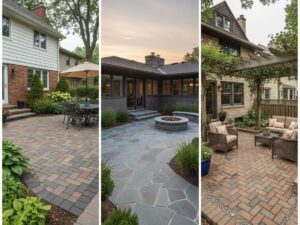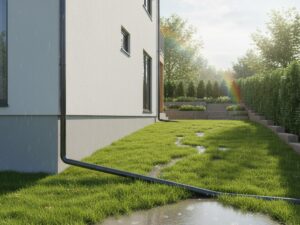Too many landscaping projects fall apart under the weight of weeds, soggy soil, and mounting maintenance costs. Without proper planning, you could end up battling poor drainage, sun-scorched plants, and inefficient irrigation systems that either flood your yard or leave it dry. These common mistakes drain your budget and steal your free time. But you don’t have to learn the hard way. By focusing on the best Landscaping Practices from the start, like testing soil, mapping sunlight, and choosing hardy plants, you can avoid headaches and unexpected bills.
Feeling overwhelmed on where to start, don’t worry, we are here to make it simple for you! In this blog post, we’ll cover 11 key considerations to help you design a landscape that looks stunning and stays easy to manage.
What to Consider in Detailed Landscaping Practices
1. Comprehensive Site Analysis
Begin your list of best landscaping practices with an in-depth site inventory that includes
- Topography & Drainage: map slopes, elevations, swales; understand how water moves across the property to prevent erosion or pooling.
- Existing Vegetation and Wildlife: catalogue trees, shrubs, habitats (including invasive species), and wildlife corridors to preserve ecological assets.
- Built Infrastructure & Utilities: locate structures, underground lines, property lines, and access points to avoid conflicts during construction.
- Microclimate and Sun/wind Patterns: track sun position, seasonal shade, wind direction, and intensity to inform plant placement and comfort zones.
- Contextual and Cultural Context: study neighbouring land uses, views, zoning/legal constraints, and any historic or cultural elements that could shape design decisions
2. Soil Quality and Drainage
Effective landscaping practices prioritize soil health and water movement:
- Soil Testing: Analyze pH, texture (sand/silt/clay), organic content, fertility, and existing compaction to assess suitability.
- Drainage Mapping: Determine infiltration and runoff zones using soil data + topography to locate rain gardens, swales, or soakaways.
- Amendments & Conditioning: Adjust pH as needed, enrich with compost, and apply organic matter to improve structure, nutrient cycling, and water retention.
3. Climate and Microclimate
- Regional Climate Data: In the list of another important landscaping practices is to review regional climate data. Which includes average temperatures, rainfall levels, frost and freeze dates, and prevailing wind patterns. Understanding these elements helps you select plants that can flourish year-round and determine what kind of irrigation, drainage, or seasonal care may be required.
- Localized Zones: Examine your site for localized microclimates. These are small zones where conditions differ slightly due to surrounding structures or terrain. For example, areas near walls may reflect excess heat, low spots may collect cold air, creating frost pockets, and narrow spaces between buildings can act as wind tunnels. By identifying these conditions, you can strategically choose plant varieties and design features for optimal growth and comfort.
4. Plant Selection
- Native & Drought-resistant Species: Maximize ecological balance, reduce maintenance, and adapt to local conditions.
- Layered Planting: Combine canopy trees, mid-story shrubs, and groundcovers for structural depth, habitat, and seasonal interest.
- Evergreen/deciduous Balance: Ensure winter structure and summer foliage; integrate pollinator-friendly species to support biodiversity.
- Hydrozoning Principles: Group plants by water needs to fine-tune irrigation efficiency and health.
5. Water Management
- Drip/Micro-irrigation: Deliver precise, root-level watering that minimizes evaporation. Subsurface drip systems are especially efficient in water-scarce regions.
- Rainwater Harvesting: Install rain barrels or cisterns with first-flush diverters to reuse runoff, reduce municipal water reliance, and buffer supply during dry spells.
- Permeable Paving & Bioswales: Promote groundwater recharge and minimize runoff by incorporating porous surfaces and vegetated channels.
6. Sustainability & Eco-Friendly Strategies
- Xeriscaping Principles: Employ soil improvements, mulching, water-wise plant choices, and reduced lawns to cut irrigation by 60%+ and lower upkeep.
- Organic Soil Building: Use composting, mulching, and minimal chemical interventions to support soil biology and plant health.
- Recycled/local Hardscape: Use reclaimed timber, local stone, or recycled plastics/wood composites to minimize carbon footprint.
- Greening Infrastructure: Green roofs retain up to 75% of rainfall, cool buildings, and improve stormwater management.
7. Realistic Maintenance Planning
One of the most overlooked yet vital landscaping practices is ensuring the design remains maintainable over time:
- Low-maintenance Planting Design: Favor perennials, native groundcovers, and slow-growing grasses that reduce pruning and care effort.
- Design for Maturity: Anticipate plant growth to avoid overcrowding or replacement; plan pathways wide enough to accommodate growth.
- Functional Ease: Include easy-care water access points, waste bin sinks, and storage for tools to keep maintenance streamlined.
8. Aesthetic & Spatial Design
- Visual Balance: Utilize symmetry, asymmetry, focal points, and sight lines to create visually engaging compositions.
- Material Palettes & Color Harmony: Blend hardscape materials (stone, wood, metal) with foliage colors and seasonal blooms for cohesion.
- Focal Features: Integrate sculptural elements, water features, or architectural accents to anchor spaces and draw attention.
9. Practical Use & Spatial Function
- Activity Zoning: Define areas for dining, play, relaxation, work, and utility to reflect real user needs and patterns.
- Circulation & Accessibility: Plan pathways that are direct, comfortable, and safe; use paved or firm surfaces with the help of paver installation contractors for mobility-friendly design.
- Adaptable Design: leave room for future change (e.g., movable seating, multipurpose lawn) depending on evolving household needs.
10. Sunlight Analysis & Shading Strategy
- Sun Mapping: Track seasonal sun exposure through the day to guide plant placement and seating comfort.
- Shade Design: Position trees, pergolas, or shade sails where afternoon shade is desirable, such as dining or relaxation zones.
11. Hardscape Integration
- Define Spaces Structurally: Use patios, retaining walls, steps, pergolas, fire pits, and lighting to shape outdoor rooms.
- Material Selection: Choose durable, climate-suited materials; coordinate textures and colors to link hardscape with plant palette.
- Low Impact Design: Install permeable hardscapes, integrate rain tanks, and ensure longevity with minimal maintenance costs.
To wrap up
By carefully implementing the landscaping considerations above, you can create a space that is not only beautiful but also functional, sustainable, and cost-efficient. Need expert advice for your landscaping? Reach out to My Landscape Contractor. With over 15 years of experience in creating breathtaking outdoor environments, we understand what it takes to turn ordinary spaces into extraordinary landscapes. From modern garden designs to functional outdoor living areas, we’ve helped hundreds of homeowners with landscaping services.




